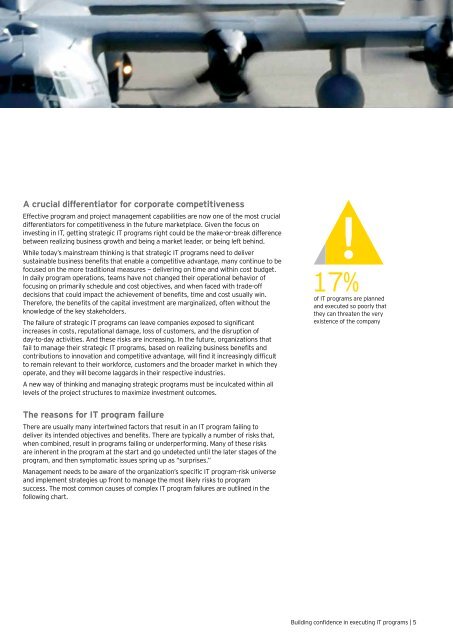Building confidence in executing IT programs
1MvMFcE
1MvMFcE
- No tags were found...
You also want an ePaper? Increase the reach of your titles
YUMPU automatically turns print PDFs into web optimized ePapers that Google loves.
A crucial differentiator for corporate competitiveness<br />
Effective program and project management capabilities are now one of the most crucial<br />
differentiators for competitiveness <strong>in</strong> the future marketplace. Given the focus on<br />
<strong>in</strong>vest<strong>in</strong>g <strong>in</strong> <strong>IT</strong>, gett<strong>in</strong>g strategic <strong>IT</strong> <strong>programs</strong> right could be the make-or-break difference<br />
between realiz<strong>in</strong>g bus<strong>in</strong>ess growth and be<strong>in</strong>g a market leader, or be<strong>in</strong>g left beh<strong>in</strong>d.<br />
While today’s ma<strong>in</strong>stream th<strong>in</strong>k<strong>in</strong>g is that strategic <strong>IT</strong> <strong>programs</strong> need to deliver<br />
susta<strong>in</strong>able bus<strong>in</strong>ess benefits that enable a competitive advantage, many cont<strong>in</strong>ue to be<br />
focused on the more traditional measures — deliver<strong>in</strong>g on time and with<strong>in</strong> cost budget.<br />
In daily program operations, teams have not changed their operational behavior of<br />
focus<strong>in</strong>g on primarily schedule and cost objectives, and when faced with trade-off<br />
decisions that could impact the achievement of benefits, time and cost usually w<strong>in</strong>.<br />
Therefore, the benefits of the capital <strong>in</strong>vestment are marg<strong>in</strong>alized, often without the<br />
knowledge of the key stakeholders.<br />
The failure of strategic <strong>IT</strong> <strong>programs</strong> can leave companies exposed to significant<br />
<strong>in</strong>creases <strong>in</strong> costs, reputational damage, loss of customers, and the disruption of<br />
day-to-day activities. And these risks are <strong>in</strong>creas<strong>in</strong>g. In the future, organizations that<br />
fail to manage their strategic <strong>IT</strong> <strong>programs</strong>, based on realiz<strong>in</strong>g bus<strong>in</strong>ess benefits and<br />
contributions to <strong>in</strong>novation and competitive advantage, will f<strong>in</strong>d it <strong>in</strong>creas<strong>in</strong>gly difficult<br />
to rema<strong>in</strong> relevant to their workforce, customers and the broader market <strong>in</strong> which they<br />
operate, and they will become laggards <strong>in</strong> their respective <strong>in</strong>dustries.<br />
A new way of th<strong>in</strong>k<strong>in</strong>g and manag<strong>in</strong>g strategic <strong>programs</strong> must be <strong>in</strong>culcated with<strong>in</strong> all<br />
levels of the project structures to maximize <strong>in</strong>vestment outcomes.<br />
17%<br />
of <strong>IT</strong> <strong>programs</strong> are planned<br />
and executed so poorly that<br />
they can threaten the very<br />
existence of the company<br />
The reasons for <strong>IT</strong> program failure<br />
There are usually many <strong>in</strong>tertw<strong>in</strong>ed factors that result <strong>in</strong> an <strong>IT</strong> program fail<strong>in</strong>g to<br />
deliver its <strong>in</strong>tended objectives and benefits. There are typically a number of risks that,<br />
when comb<strong>in</strong>ed, result <strong>in</strong> <strong>programs</strong> fail<strong>in</strong>g or underperform<strong>in</strong>g. Many of these risks<br />
are <strong>in</strong>herent <strong>in</strong> the program at the start and go undetected until the later stages of the<br />
program, and then symptomatic issues spr<strong>in</strong>g up as “surprises.”<br />
Management needs to be aware of the organization’s specific <strong>IT</strong> program-risk universe<br />
and implement strategies up front to manage the most likely risks to program<br />
success. The most common causes of complex <strong>IT</strong> program failures are outl<strong>in</strong>ed <strong>in</strong> the<br />
follow<strong>in</strong>g chart.<br />
<strong>Build<strong>in</strong>g</strong> <strong>confidence</strong> <strong>in</strong> execut<strong>in</strong>g <strong>IT</strong> <strong>programs</strong> | 5



